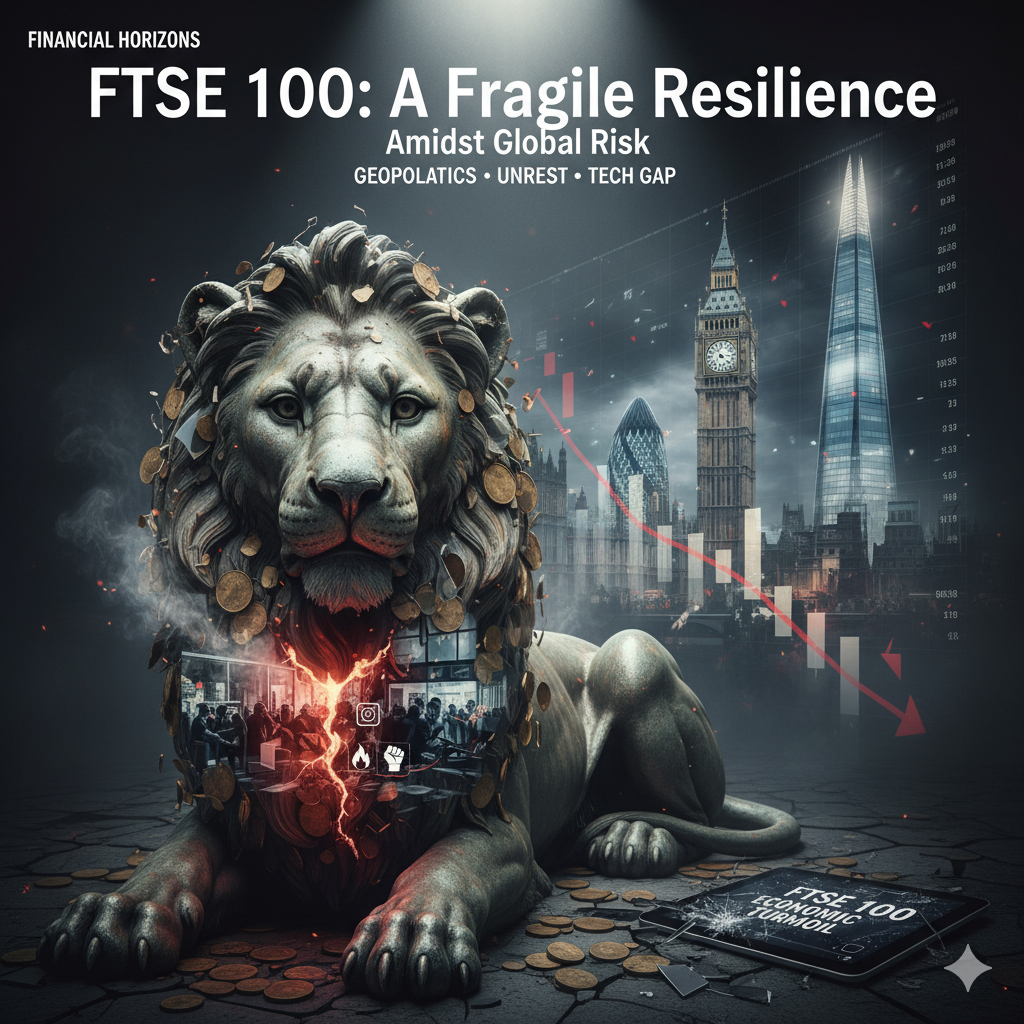1. Market Mechanics: Triple-Leverage Amplifies Geopolitical Risk
1.1 The Nasdaq-100 as the Global Technology Bellwether
The Nasdaq-100 Index (NDX) functions as the definitive global benchmark for technology and innovation leadership. The index is structurally concentrated, allocating 61% of its weighting to technology sectors.1 Furthermore, “new economy” sectors, including technology, consumer discretionary, and health care, collectively represent 85% of the NDX.1 This extreme concentration makes the index highly sensitive to shifts in global growth expectations and geopolitical stability. NDX performance relies crucially on flawless global supply chains and optimistic forward-looking sentiment.
1.2 SQQQ: Strategic Instrument for Profiting from NDX Downturns
ProShares UltraPro Short QQQ (SQQQ) is a sophisticated financial instrument offering leveraged inverse market exposure.2 SQQQ aims for daily investment results corresponding to three times the inverse $(-3\text{x})$ of the daily performance of the Nasdaq-100 Index.2 This triple-inverse structure provides a strategic mechanism for investors seeking to profit from anticipated market declines.2 Importantly, SQQQ provides this leveraged short exposure without mandating the use of a traditional margin account.3 This setup may mitigate typical risks associated with margin trading while potentially amplifying performance during steep index drops.3
1.3 Understanding Triple-Inverse Exposure and Compounding Risk
Sophisticated investors strategically utilize SQQQ to hedge their overall portfolios against expected downturns in the technology-heavy NDX.3 The triple-exposure design allows investors to risk a relatively smaller amount of capital to counterbalance daily market risk on existing holdings.3 Geopolitical instability rarely causes linear declines in asset prices; instead, it typically triggers sharp, non-linear spikes in financial market volatility.4 Heightened volatility, fueled by geopolitical events, leads investors toward caution, negatively affecting trading decisions and driving down stock prices.5 SQQQ’s daily compounding mechanism is optimized for capturing these high-volatility, directional downside movements. Escalating China-Japan tensions increase the probability of multiple consecutive down days, exponentially magnifying SQQQ’s positive returns. This translates small, negative NDX moves into substantial positive gains for short-side positioning.3
2. Geopolitics and Macroeconomics: Translating Friction into Financial Volatility
2.1 Geopolitics: Core Frictions Strategic Rivalry and Territorial Disputes
Persistent geopolitical friction between China and Japan introduces systemic regional instability across the Asia-Pacific. The territorial dispute centered on the Diaoyu/Senkaku Islands remains a critical flashpoint in Sino-Japanese relations.6 Institutional investors now regard this ongoing tension as a material threat to the stability of global trade and the integrity of transnational supply chains.
2.2 Geostrategy: Economic Coercion and the Sanctions Weapon
China’s immense economic power allows it to increasingly use economic sanctions as a strategic component of its diplomatic and geopolitical portfolio.6 Escalation of these disputes makes targeted sanctions against major Japanese industries (or vice-versa) a high-probability event. China previously opposed economic sanctions, but internal discussions suggest a willingness to leverage economic clout for political objectives.6 This strategic pivot toward coercion introduces significant, unpriced systemic risk into global technology value chains.
2.3 Macroeconomics: Geopolitical Risk Premium and Capital Repricing
Major geopolitical events, particularly military conflicts and sustained inter-state tensions, have a disproportionately large and persistent effect on asset prices.4 The realization of these geopolitical risks immediately raises financial market volatility.4 This dramatic increase in uncertainty establishes a higher Geopolitical Risk Premium (GPRP) across global financial markets. High-growth technology stocks, whose valuations depend heavily on distant future cash flows, are especially vulnerable. A persistently higher GPRP necessitates higher discount rates for future NDX earnings projections. This development leads directly to immediate equity repricing and substantial negative price pressure, benefiting SQQQ.
2.4 Economics: Trade Fragmentation and NDX Revenue Exposure
The Nasdaq-100 index maintains a significant international footprint, deriving almost 50% of its revenues from outside the United States.1 Companies comprising the NDX derive approximately 10% of their total revenues specifically from Mainland China.7 Economic fragmentation resulting from the escalating China-Japan conflict directly threatens this vital revenue stream. Such conflict accelerates the global trend toward regionalization of supply networks, reversing decades of optimizing for global efficiency.8 Companies may find themselves shut out of foreign markets due to trade wars or heightened regulatory hostility.9 This reversal of globalization severely undermines the projected earnings growth of globally exposed NDX firms.
3. Technology and High-Tech Exposure: NDX’s Achilles’ Heel
3.1 Industry Trends: Overconcentration Risk and Supply Chain Stress
The structural concentration of the NDX in sectors like Semiconductors and Production Technology Equipment ensures maximum exposure to physical supply chain risks in Asia.7 While the NDX’s mix of services-oriented companies provides some insulation against broad tariff policies, the underlying physical movement of high-value components remains acutely vulnerable to instability across the Pacific.7 Robust earnings growth in these technology sub-sectors depends directly on smooth, uninterrupted Asian supply flows. This index profile amplifies the systemic risk of geopolitical friction.
3.2 Technology: International Revenue Dependence and Retaliation Risk
The global revenue dependence of the NDX exposes its constituent companies to compounded market risks. Nearly half of the index’s revenue originates internationally.7 A severe geopolitical conflict between China and Japan poses a double threat to NDX corporate earnings. First, the 10% direct China revenue 7 becomes instantly vulnerable to state-directed sanctions or consumer boycotts. Second, disruption in Japanese markets, combined with potential secondary boycotts, erodes the total international revenue base.1 This simultaneous negative impact on two major markets necessitates sharp negative earnings revisions, accelerating the downside trajectory necessary for SQQQ gains.
3.3 High-Tech: AI Valuation Risk and Investor Flight
Geopolitical stress frequently acts as a catalyst for widespread institutional liquidation in high-beta assets.10 The Artificial Intelligence (AI) sector, which drives significant recent NDX performance, carries notably high valuations.10 High-beta risk proxies, such as Bitcoin, often mirror nervous downside movements in equity indices, intensifying the perception of tightening liquidity and heightened risk aversion.10 Escalating China-Japan tensions provide a clear, compelling rationale for the rapid institutional liquidation of these highly valued AI and technology stocks. This swift liquidation ensures the steep daily price declines that maximize the returns of SQQQ.
4. Critical Supply Chains: Geostrategic Chokepoints
4.1 Science/Materials: China’s Rare Earth Dominance and Global Vulnerability
Rare Earth Elements (REEs) are indispensable components for advanced technologies, including EV motors, specialized sensors, and advanced defense systems.11 China maintains a near-monopoly on processing, controlling nearly 90% of global REE separation and processing capacity.11 Furthermore, China supplies roughly 60% of the world’s REE output.11 This dominance represents a critical chokepoint for the entire global technology ecosystem dependent on permanent magnets and conductive materials.
4.2 Rare Earth Weaponization: Direct Threat to Technology Sectors
China has demonstrated its willingness to weaponize its REE dominance, notably restricting exports to Japan during a diplomatic dispute over the Diaoyu Islands.13 This action proves the geopolitical utility of the REE supply chain as an economic weapon. A renewal of this restriction would immediately threaten Japanese auto manufacturing and high-tech sectors, creating a severe component shortage for NDX firms operating in EV, defense, and AI.11 Such an input material constraint directly translates into production halts and consequent share price depreciation.
4.3 Semiconductors: Japan’s Critical Role in Fabrication Materials
Japan maintains a uniquely indispensable role in the upstream semiconductor supply chain. The nation holds a substantial 50% global market share in numerous categories of critical semiconductor materials.14 These materials, which include specialized photoresists, are fundamental requirements for advanced global chip manufacturing.14 Disruption of these flows, whether due to sanctions or physical instability, is equivalent to halting fabrication capacity for NDX companies utilizing sophisticated chips.
4.4 Geopolitical Decoupling: Japan’s Strategy for De-Risking
Japan proactively recognizes semiconductors as critical for national economic security.15 The government implements extensive public-private initiatives, including the JPY200 billion Post-5G Fund and the JPY2 trillion Green Innovation Fund, to support domestic industry revival.15 Major fabrication players, such as TSMC, are expanding manufacturing presence in Japan, partially to de-risk key supply chains.16 While this regionalization improves long-term security, the shift from global optimization to resilience necessitates massive capital expenditure.15 This capital requirement immediately increases production costs for NDX clients using these regionalized sources, resulting in compressed short-term profit margins that erode equity valuations.
Table 1: Nasdaq-100 Vulnerability Mapping to East Asian Risk
| NDX Metric | Source | Exposure Type | SQQQ Appreciation Driver |
| Technology Weighting: 61% | 1 | Sector Concentration | Magnifies impact of supply chain disruptions in semiconductors and REEs. |
| Mainland China Revenue: $\sim 10\%$ | 7 | Direct Market Risk | Vulnerable to Chinese retaliatory sanctions or consumer boycotts. |
| Rare Earth Dependency: High | 11 | Input Material Chokepoint | Weaponization halts production of EV, defense, and AI components 12 |
| Japanese Material Dependency: 50% Share | 14 | Upstream Supply Risk | Disruption of photoresists and other critical fabrication materials halts global chip flow. |
| AI Valuation Concern: High Beta | 10 | Liquidity Risk | Geopolitical tension acts as the trigger for institutional risk liquidation. |
5. Corporate Strategy and Resilience
5.1 Management & Leadership: Strategic Imperatives for Geopolitical Due Diligence
Corporate boards must establish robust, dedicated mechanisms for monitoring geopolitical risk.17 Geopolitical risk analysis is a specialty requiring specific expertise and experience, often necessitating third-party support.17 Effective management demands quantifying these risks based on potential revenue impact, rather than limiting analysis to cost exposure 8 Failure to anticipate geopolitical shocks in critical Asian hubs constitutes a core governance failure that directly threatens shareholder value. Upstream consideration of geopolitical risk before decision-making is now non-negotiable.17
5.2 Business Models: Pivot from Globalization to Localization and Nearshoring
Geopolitical rivalry forces technology firms to implement costly business model pivots.9 Firms are aggressively regionalizing supply chains, with almost two-thirds (64%) of surveyed companies reporting this shift.8 Companies are moving production away from geopolitical hotspots, often to Mexico or Vietnam, when supplying North American markets.9 This mandated transition, prioritizing resilience over global efficiency, necessitates significant increases in OpEx and CapEx. This structural change reduces short-term profitability and challenges existing high-growth valuations, strengthening the bearish case for the NDX.
5.3 Company Culture & Innovation: The Cost of Uncertainty on R&D
Geopolitical uncertainty directly correlates with reduced corporate innovation output.18 Management teams typically become risk-averse in periods of high macro-uncertainty, leading to the cutting or deferral of long-term R&D spending. This strategic contraction diminishes the continuous technological advantage that historically sustains NDX stock valuations. High levels of financial market volatility and uncertainty act as a significant deterrent to future capital investment.
5.4 Patent Analysis: Reduced Collaboration and Declining Innovation Quality
Geopolitical fragmentation severely disrupts established cross-border research collaborations, impacting the innovation output of organizations 19 Evidence shows a shift in patenting focus and a reduction in the quantity and quality of patents filed.18 For technology firms, intellectual property constitutes the primary asset and competitive moat. A demonstrable reduction in patent quality and citation rates fundamentally erodes the long-term intellectual property value of high-tech firms.18 This tangible degradation in future technological leadership provides a strong structural bearish argument against NDX firms.
6. Cyber Warfare and Operational Security
6.1 Cyber: State-Sponsored Cyberattacks and Critical Infrastructure Pre-positioning
Escalating tensions increase the likelihood of sophisticated state-sponsored cyber operations targeting US and allied interests. The Cybersecurity and Infrastructure Security Agency (CISA) assesses that PRC state-sponsored cyber actors are actively pre-positioning themselves on U.S. critical infrastructure networks.20 This preparation aims to enable disruptive or destructive attacks during a major crisis or conflict.20 Japan reported that the Chinese military previously ordered cyberattacks against approximately 200 Japanese companies and research institutes.21
6.2 Supply Chain Cyber Risk: Exploiting Trust for Geopolitical Objectives
Supply chain compromise has become a central geopolitical attack vector.22 Adversaries exploit the growing digital interdependence of the extended OT ecosystem, often targeting specific vendors or technologies based on geopolitical motives.22 This tactic enables state actors to inflict severe economic damage by compromising supply chain trust, leading to physical disruptions.22 Vulnerabilities are amplified when adversaries target upstream dependencies.
6.3 Operational Security: High Financial Stakes of Supply Chain Compromise
A severe, successful cyberattack targeting a critical Japanese semiconductor or material supplier could force an immediate operational shutdown across the NDX supply chain. Such cyber-induced production halts are immensely costly, resulting in estimated losses potentially reaching billions in lost revenue (e.g., up to $1.7$ billion in lost revenue in a prior automotive case).23 Cyber threats now rank alongside traditional geopolitical shocks and tariff disputes as the largest risk for international procurement managers.23 This high-impact, non-kinetic warfare scenario provides the most immediate, sharp catalyst for NDX decline.
6.4 IP Protection: Cyber Espionage and Targeted Acquisition of High-Tech Assets
China systematically targets proprietary intellectual property and trade secrets of foreign companies through state-directed plans.24 Intelligence services are sometimes used to steal IP to support national strategic goals.24 The annual cost to the U.S. economy from such cyber-enabled IP theft is estimated between $225 billion and $600 billion.24 Escalating tensions intensify this state-sponsored espionage, directly threatening the proprietary technological innovation that forms the basis of NDX market leadership.
7. Conclusions and Strategic Implications
Escalating China-Japan tensions create a comprehensive, multi-domain risk environment that generates substantial appreciation for ProShares UltraPro Short QQQ (SQQQ). The appreciation is driven by a complex, leveraged translation of geopolitical risk into financial volatility. NDX valuations are fundamentally compromised by dependence on critical Asian supply chain chokepoints, particularly Chinese rare earths and Japanese advanced semiconductor materials 11
The strategic weaponization of these supply chain dependencies presents an immediate, tangible production risk. Simultaneously, the corporate response of regionalization and nearshoring imposes long-term margin compression through elevated capital and operating expenditures.8 The elevated geopolitical risk establishes a necessary, higher discount rate, directly challenging the aggressive valuations of the high-beta technology sector.4
The greatest acute threat involves non-kinetic warfare, where state-sponsored cyber operations pre-positioned against critical infrastructure 20 carry the potential for sudden, catastrophic operational disruption across global technology supply chains. These compounded risks guarantee increased volatility and a fundamental reassessment of future NDX earnings growth. This environment is optimally suited for the triple-inverse exposure provided by SQQQ, validating its strategic role as a leveraged hedge against deepening geopolitical fragmentation in the Asia-Pacific region. Investment committees must incorporate this heightened Geopolitical Risk Premium into all NDX-related valuation models.
SQQQ Long (Buy)
Enter At: 16.85
T.P_1: 33.81
T.P_2: 53.97
T.P_3: 70.84
T.P_4: 86.43
T.P_5: 114.10
T.P_6: 138.62
T.P_7: 168.90
S.L: 3.06



























































































